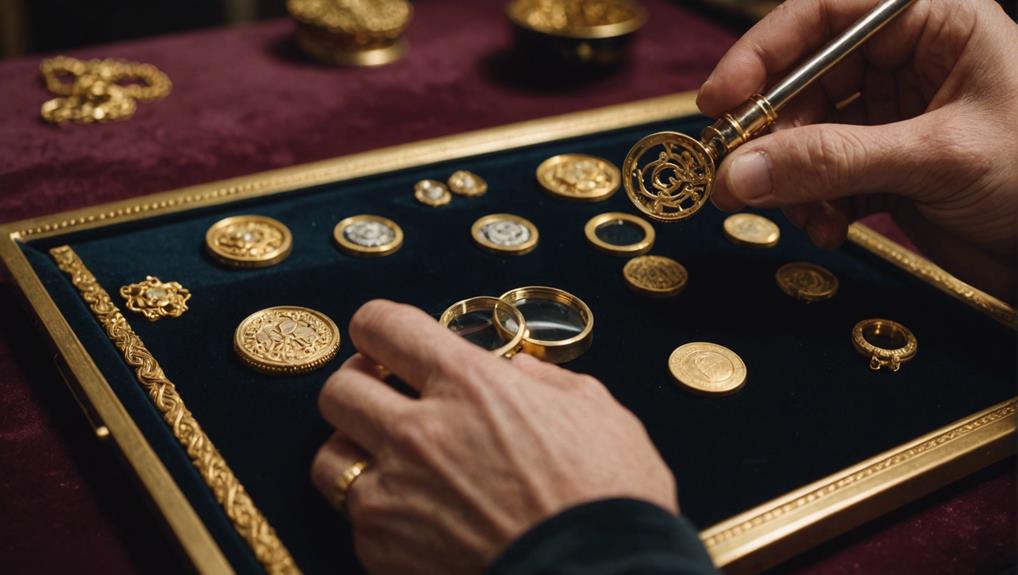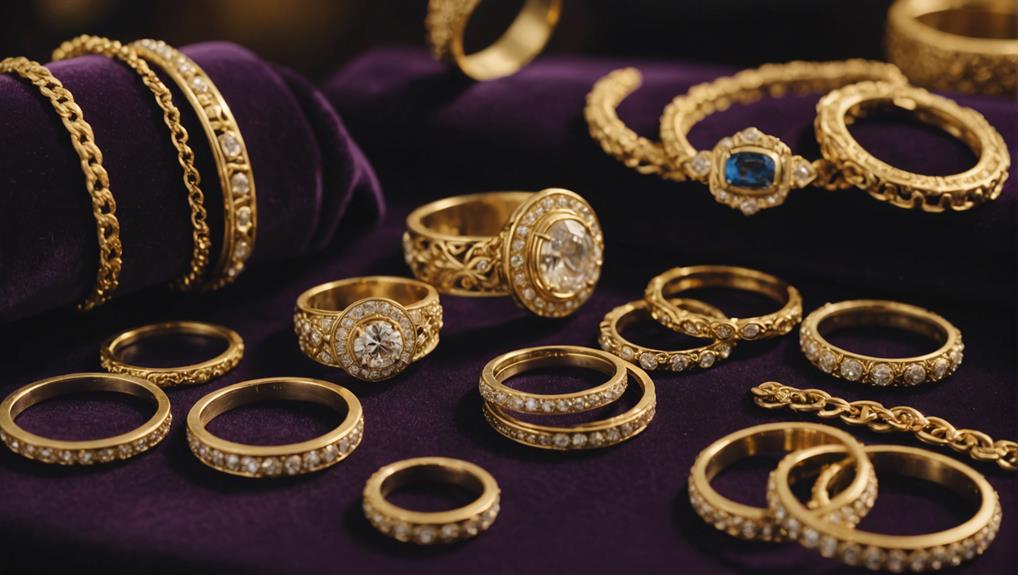Investing in gold jewelry requires a thorough understanding of how to maximize returns when investing in gold jewelry, gold purity, and hallmarks, as these indicators reveal the quality and true value of the piece.
Distinguishing between solid gold and gold-plated items is crucial to avoid costly mistakes.
The craftsmanship and intricate designs of the jewelry play a significant role in ensuring your investment retains its value over time.
Additionally, evaluating the seller’s reputation and staying informed about current market prices will guide you toward making a smart purchase.
Ready to make an informed decision? Let’s explore these essential tips in detail.
My Quick Highlights
- Check the hallmarks such as 375, 585, or 750 to verify the gold’s purity.
- Opt for solid gold instead of gold-plated to ensure lasting value and durability.
- Assess the craftsmanship and design quality to ensure long-term value retention.
- Review the seller’s reputation through customer reviews and accreditations like the Better Business Bureau.
- Track gold market prices and trends to make informed investment decisions.
Research Gold Purity and Hallmarks

Understanding gold purity and hallmarks is crucial when investing in gold jewelry to ensure you’re acquiring genuine and high-quality pieces. Gold purity, measured in karats, indicates the percentage of pure gold in an alloy. Common classifications include 10K, 14K, 18K, and 24K.
For example, ‘585’ signifies 14K gold, while ‘750’ denotes 18K gold. European gold jewelry often features hallmarks such as 375, 585, or 750, which correspond to specific purity levels. Familiarizing yourself with these hallmarks can help you avoid counterfeit or low-quality jewelry.
This knowledge is essential during a jewelry appraisal, as these marks determine the piece’s value and authenticity, ensuring a sound investment.
Understand Solid Gold Vs Gold-Plated
Understanding the difference between solid gold and gold-plated jewelry is essential for making informed decisions.
Solid gold jewelry is composed entirely of gold alloy, providing superior durability and value. It’s often marked with purity levels such as 10K, 14K, 18K, or 24K, which indicate the gold content.
Gold-plated jewelry, on the other hand, features a thin layer of gold over a base metal, offering a more cost-effective option. However, this gold layer can wear off over time, diminishing its longevity and value.
Solid gold pieces generally offer lasting worth, while gold-plated items may lack consistent markings. Understanding these distinctions enables you to select the right type of gold jewelry for your needs and investment.
Consider Craftsmanship and Design

When investing in gold jewelry, the craftsmanship and design of each piece are paramount. High-quality craftsmanship and intricate designs can significantly enhance the value and longevity of your investment. A skilled goldsmith’s touch ensures not just aesthetic appeal but also durability and quality.
To make a wise choice, consider the following aspects:
- Intricate Designs: Seek out detailed and unique patterns that demonstrate superior artistry.
- Handcrafted Pieces: These typically offer higher quality and distinctiveness.
- Hallmarking: Confirm the authenticity and purity of the gold.
- Artistry: Well-crafted designs tend to retain their value better over time.
Evaluate Seller Reputation
Evaluating the seller’s reputation is crucial for a safe and worthwhile investment in gold jewelry. Check reviews and ratings on platforms like Yelp or Google to gauge customer satisfaction. Look for accreditation from organizations such as the Better Business Bureau to verify credibility. Assess the seller’s years of experience in the industry to determine their expertise and trustworthiness. Seek recommendations from friends or family who have made successful purchases. Visiting the seller’s physical store can also be beneficial to inspect the quality of their gold jewelry firsthand.
| Aspect | What to Check | Why It Matters |
|---|---|---|
| Reviews and Ratings | Yelp, Google | Gauge customer satisfaction |
| Accreditation | Better Business Bureau | Verify seller’s credibility |
| Years of Experience | Industry tenure | Determine expertise and trustworthiness |
Factor in Market Price of Gold

Pay close attention to the market price of gold, which fluctuates daily and directly affects the value of your investment. The gold price index is influenced by supply and demand, global economic conditions, and geopolitical events. Monitoring these fluctuations helps determine optimal buying or selling times.
Steps to consider:
- Track historical gold price data to identify trends.
- Monitor economic indicators such as economic downturns that can impact gold prices.
- Diversify your investment portfolio to reduce risks.
- Consult reputable sources for gold price forecasts and charts.
Conclusion
By keeping these tips in mind, you’ll make informed decisions when investing in gold jewelry. Prioritize understanding gold purity and hallmarks.
Distinguish between solid gold and gold-plated pieces. Appreciate the importance of craftsmanship and design.
Always evaluate the seller’s reputation. Consider the current market price of gold. These steps will help ensure that your investment is both valuable and enduring.
The Gold Information Network
11900 Biscayne Blvd, Ste 127B, Miami, FL 33181
(305) 449-9094
https://goldinfo.net







